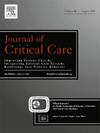Antibiotic allergy de-labeling in the intensive care unit: The prospective ADE-ICU study
IF 3.2
3区 医学
Q2 CRITICAL CARE MEDICINE
引用次数: 0
Abstract
Purpose
Critically ill patients in the intensive care unit (ICU) are frequently prescribed antibiotics, with many reporting an antibiotic allergy label, predominantly to penicillin. Mislabeling contributes to suboptimal antibiotic use, increasing multidrug-resistant organisms and Clostridium difficile infections, and increased hospital length of stay. This prospective study implemented an antibiotic allergy assessment and testing program in the ICU, independently of clinical immunology/allergy services.
Materials and methods
Trained ICU staff prospectively identified and risk assessed eligible patients as having a non-immune mediated drug reaction, or a low, intermediate or high risk antibiotic allergy. Non-immune mediated reactions were directly de-labeled. Low-risk allergies underwent direct drug provocation testing, while intermediate-risk allergies included skin testing followed by drug provocation testing. High-risk allergies were confirmed without testing.
Results
Of 71 eligible patients, 62 underwent assessment. Antibiotic allergy de-labeling occurred in 48 of 51 patients (94 %) with a non-immune, low or intermediate risk allergy. High risk allergies were confirmed in 11 patients (18 %). The study resulted in increased penicillin use and decreased broad-spectrum antibiotic use. No adverse events occurred from testing.
Conclusions
This study shows the feasibility of ICU led antibiotic allergy assessment and testing, highlighting a potential model for implementation in settings lacking immunology/allergy services.
重症监护室中的抗生素过敏去标签化:前瞻性 ADE-ICU 研究
目的重症监护室(ICU)中的重症患者经常被处方抗生素,其中许多人报告了抗生素过敏标签,主要是对青霉素过敏。标示不当会导致抗生素使用不达标、耐多药菌和艰难梭菌感染增加以及住院时间延长。这项前瞻性研究在重症监护病房实施了一项抗生素过敏评估和检测计划,独立于临床免疫学/过敏服务。材料和方法经过培训的重症监护病房工作人员前瞻性地将符合条件的患者识别为非免疫介导的药物反应或低、中或高风险抗生素过敏患者,并进行风险评估。非免疫介导反应直接去标签。对低风险过敏者直接进行药物激发试验,对中风险过敏者先进行皮肤测试,然后再进行药物激发试验。结果 71 名符合条件的患者中有 62 人接受了评估。51 名患者中有 48 人(94%)对非免疫、低度或中度过敏发生了抗生素过敏。有 11 名患者(18%)确认了高风险过敏。这项研究增加了青霉素的使用,减少了广谱抗生素的使用。结论这项研究显示了 ICU 主导的抗生素过敏评估和检测的可行性,突出了在缺乏免疫学/过敏服务的环境中实施的潜在模式。
本文章由计算机程序翻译,如有差异,请以英文原文为准。
求助全文
约1分钟内获得全文
求助全文
来源期刊

Journal of critical care
医学-危重病医学
CiteScore
8.60
自引率
2.70%
发文量
237
审稿时长
23 days
期刊介绍:
The Journal of Critical Care, the official publication of the World Federation of Societies of Intensive and Critical Care Medicine (WFSICCM), is a leading international, peer-reviewed journal providing original research, review articles, tutorials, and invited articles for physicians and allied health professionals involved in treating the critically ill. The Journal aims to improve patient care by furthering understanding of health systems research and its integration into clinical practice.
The Journal will include articles which discuss:
All aspects of health services research in critical care
System based practice in anesthesiology, perioperative and critical care medicine
The interface between anesthesiology, critical care medicine and pain
Integrating intraoperative management in preparation for postoperative critical care management and recovery
Optimizing patient management, i.e., exploring the interface between evidence-based principles or clinical insight into management and care of complex patients
The team approach in the OR and ICU
System-based research
Medical ethics
Technology in medicine
Seminars discussing current, state of the art, and sometimes controversial topics in anesthesiology, critical care medicine, and professional education
Residency Education.
 求助内容:
求助内容: 应助结果提醒方式:
应助结果提醒方式:


